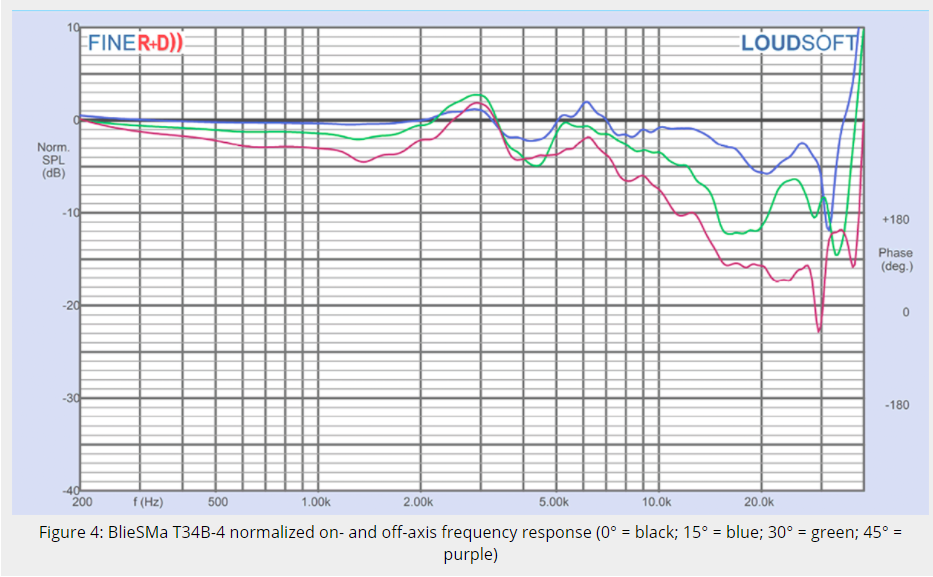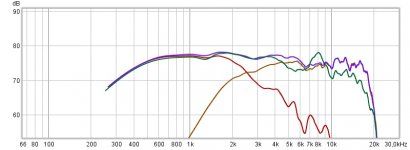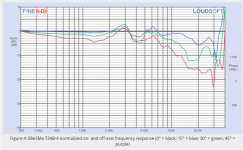The dispersion of the woofers has actually been simulated. There was no directivity whatsoever up to about 270 Hz. The woofers have always been crossed at 250 Hz and it works perfectly. Sounds great.
If I where to reduce the cabinet volume the cabinet would become less deep and so the plane on which the woofers are mounted would become less wide. The effect would be very small because of the wavelength but this should in theory result in even less directivity of the woofers.
If I where to reduce the cabinet volume the cabinet would become less deep and so the plane on which the woofers are mounted would become less wide. The effect would be very small because of the wavelength but this should in theory result in even less directivity of the woofers.
All what matters is that you like it.
Stating that things Work perfectly without having tried (a lot) other filters, is one sure way to not know, How much things could be improved.
Stating that things Work perfectly without having tried (a lot) other filters, is one sure way to not know, How much things could be improved.
I measured the off axis response of the tweeter on it's own. The spike also shows up there. So that's just the off-axis response of the tweeter. Nothing I can do about it now without changing the on axis response.
You know the round top of the speakers? The radius of that is 8,3 cm. 34300 / 8,3 * 2 (1/2 wavelength) = 8265 Hz. So it's probably the round top that is amplifying and causing that spike. So it's a good thing the new pair will have an angular top. Then this spike shouldn't show up.
You know the round top of the speakers? The radius of that is 8,3 cm. 34300 / 8,3 * 2 (1/2 wavelength) = 8265 Hz. So it's probably the round top that is amplifying and causing that spike. So it's a good thing the new pair will have an angular top. Then this spike shouldn't show up.
^+1.
I think you identified the cause.
When you eq on one axe and the thing you tried to eq reappear somewhere else it is non minimum phase issue.
I think you identified the cause.
When you eq on one axe and the thing you tried to eq reappear somewhere else it is non minimum phase issue.
What’s the logical formula behind this magic number 34300 I see everywhere? Speed of sound in air in cm per sec?
So I finally got to make some measurments again and play around with the crossover.
Purple is an on axis measurment. Green is 30 degrees off axis. So I seem to have the 8 kHz bump off axis. What do I do about this?
8KHz = 4.2cm wavelength. At that distance from the tweeter centre, it's unlikely to be a surface / edge induced artefact (about the only thing there will be mounting screws and unless these protrude significantly... or your tweeter has a 8.4cm diameter faceplate and you have not flushmounted your tweeter or have a large gap in the countersink...)
If we were going with soft dome breakup (can't remember what membrane your tweeter has) then you usually see this in the 6KHz and up region. Problem though is this should not be axis dependent.
Thus it leads me back to some baffle / edge / faceplate induced bump and dip.
Oh yeah, miscalculation. Then it's 2 wavelengths at ~8 kHz.
The it's a beryllium tweeter so it shouldn't show any peaks because of dome breakup. But the tweeter right now isn't mounted flush. But it sticks out only ~1 mm. Would that be enough to cause a problem? If so this will be fixed with the new cabinets since they will obviously be flush mounted.
The it's a beryllium tweeter so it shouldn't show any peaks because of dome breakup. But the tweeter right now isn't mounted flush. But it sticks out only ~1 mm. Would that be enough to cause a problem? If so this will be fixed with the new cabinets since they will obviously be flush mounted.
Put a felt ring around the raised lip or some other thin material to see if the bump lowers on frequency. Good to eliminate this before you settle on the new design
Have a look at the normalized response of the T34-B as measured by Vance Dickason in Audioexpress.
You can see that if you make the on axis flat (black line) then there will be peaks in the off axis just due to the the tweeter's size and shape itself. The baffle it is mounted in will modify that from what is seen here but the trend is obvious. If you want even on and off axis from a large tweeter over a large bandwidth then it will most likely need a waveguide of some sort.

You can see that if you make the on axis flat (black line) then there will be peaks in the off axis just due to the the tweeter's size and shape itself. The baffle it is mounted in will modify that from what is seen here but the trend is obvious. If you want even on and off axis from a large tweeter over a large bandwidth then it will most likely need a waveguide of some sort.
Attachments
Good info fluid!
Although that Audioxpress measurements done with the tweeter mounted on a typical speaker baffle. The off-axis peaks and dips depends on the baffle and box shape as you say.
Below is an infinite baffle measurements of the same tweeter, we can see the almost omnidirectional behaviour in the low to mid-range (and the rapidly increasing directionality going up in frequency).
Personally I don't get why manufacturers produce brilliant and very expensive (or cheap) dome tweeters and sell those without any significant waveguide attached to it or not sell waveguides separately to their tweeters if someone wants to use it. Instead, they let the tweeter response (mainly the lower part) be swamped by the speaker baffle.
Furthermore it's almost impossible to match a bare dome directivity to the midrange driver without a waveguide. Of course, a waveguide need further development, maybe that's the reason, idk.
But thanks to the sacrificial work of some people, free waveguide plans are being made for popular dome tweeters.
BlieSMa T34B-4 | HiFiCompass
Although that Audioxpress measurements done with the tweeter mounted on a typical speaker baffle. The off-axis peaks and dips depends on the baffle and box shape as you say.
Below is an infinite baffle measurements of the same tweeter, we can see the almost omnidirectional behaviour in the low to mid-range (and the rapidly increasing directionality going up in frequency).
Personally I don't get why manufacturers produce brilliant and very expensive (or cheap) dome tweeters and sell those without any significant waveguide attached to it or not sell waveguides separately to their tweeters if someone wants to use it. Instead, they let the tweeter response (mainly the lower part) be swamped by the speaker baffle.
Furthermore it's almost impossible to match a bare dome directivity to the midrange driver without a waveguide. Of course, a waveguide need further development, maybe that's the reason, idk.
But thanks to the sacrificial work of some people, free waveguide plans are being made for popular dome tweeters.
BlieSMa T34B-4 | HiFiCompass
Last edited:
I have said this elsewhere. I sometimes use cork on the baffle between the driver frame and the board. This does many things but I have never actually "measured" before and after effects. You can also do a second layer of cork sheet around the drivers which acts like a recessed or flush mount. I no longer have a router but don't really need one so much these days. I would be curious if any of you guys with really good measurement suites could maybe try different configurations of cork. It certainly sounds smoother to me; way less obvious peaks and valleys with music, test tones, sweeps etc. If I can't get my mic and REW to work for me I will first try another mic; then maybe another software measurement suite?? It would be nice to have an expensive and highly accurate package but I really can't justify it for just my simple hobby these days. Thoughts? Experiences along these lines???
Put a felt ring around the raised lip or some other thin material to see if the bump lowers on frequency. Good to eliminate this before you settle on the new design
tesa precision mask tape, the yellow one, is very good to even out any imperpection between drivers and baffle, and it can stay on for months without leaving any trace of glue
https://www.scotchblue.com/3M/en_US...Painter-s-Tape-2060/?N=4336+3289983809&rt=rud
Celef, I have used this many times; it comes off clean. Some self adhesive felt strips also do well, they are sticky but come off clean as well just for quick experimenting. Many people have said that 100% lamb's wool felt is the very best; outside for diffraction abatement and inside for absorption.
Spring fever here in the middle of the USA; warm temps and nice weather finally (at least temporarily). Saturday afternoon, many people out and about and cranking up the jams!
Celef, I have used this many times; it comes off clean. Some self adhesive felt strips also do well, they are sticky but come off clean as well just for quick experimenting. Many people have said that 100% lamb's wool felt is the very best; outside for diffraction abatement and inside for absorption.
Spring fever here in the middle of the USA; warm temps and nice weather finally (at least temporarily). Saturday afternoon, many people out and about and cranking up the jams!
- Home
- Loudspeakers
- Multi-Way
- In need of warmth

